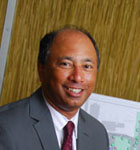1958: Garland J. Hopkins founds the firm
“The story goes,” Caldwell says, “that after the birth of his first child, Hopkins came to the hospital and told his wife, who was still recovering, that he’d just quit his job with a local engineering firm because he wanted to provide a better future for his family.” So, then and there, G. J. Hopkins, a mechanical-contracting firm, begins.
1963: Expansion into electrical contracting
Hopkins adds electrical installation to the company’s service suite, bringing in personnel with the necessary experience and technical expertise. This addition allows the firm to offer both major disciplines and become a full-service mechanical and electrical contractor.

1977: A sheet-metal shop is added
The company constructs its own sheet-metal shop (right) and begins fabrication of the material right away, allowing G. J. Hopkins better quality and cost control over a vital aspect of its mechanical projects.
1984: The Branch Group acquisition
G. J. Hopkins is acquired by the Branch Group—a parent company overseeing five subsidiaries—and is merged with Branch Mechanical, an established mechanical bid-spec contracting firm. Hopkins leaves the company, and Jerry Mormon transfers from Branch Mechanical to become the new president. Mormon’s tenure leads to a change in philosophy for the company, pushing it away from negotiation and toward a bid-spec approach. During this period, the service department grows from a warranty department into a true profit center, performing preventive-maintenance contracts, installations, and service calls. G. J. Hopkins also becomes a 100 percent employee-owned company with an employee stock-ownership plan.
1998: The era of E. Clifton
Upon retirement, Mormon is replaced by E. Clifton, who moves from the electrical department to become the new president. “Clifton brought in a healthy balance of bid-spec and negotiated work,” Caldwell says. Clifton also adds an in-house design-build department to the company’s suite of services.
2000s: growth from medical work
The company’s healthy growth to $10–15 million in sales per year is fueled by successful partnerships that bring G. J. Hopkins a number of addition, renovation, and new-build projects at hospitals. Most of these are negotiated design-build projects, and two or three are contracts in the $20–30 million realm. “We had an edge against the competition, as these larger projects were complicated and fast-tracked,” Caldwell says. “We were the only local contractor with the team capable of getting the project completed on schedule.” All of the medical projects are completed on time and within budget.

2008: Carilion Roanoke Memorial Hospital
Carilion Health Systems (now Carilion Clinic) partners with Virginia Tech University for the development of a medical school and research institute, the Carilion Roanoke Memorial Hospital (above, right). G. J. Hopkins is once again a part of the construction team. Ground is broken on the facility in September 2008, and classes begin on schedule in August 2010.

2011: Ernie Caldwell takes the reins
After 25 years of service, E. Clifton retires. With 19 years of mechanical engineering and construction experience under his belt, Ernie Caldwell is promoted to take his place. Shortly after Caldwell took the reins, the sheet-metal shop is moved into a larger, updated facility with new equipment. In this new facility, G. J. Hopkins begins prefabrication of mechanical, plumbing, and electrical systems, thus reducing the firm’s reliance on field labor. Additionally, the engineering department adds staff who have BIM expertise. This allows G. J. Hopkins to construct a three-dimensional computer model of its mechanical and electrical systems for coordination purposes prior to installation.
2012: looking ahead
In response to the economy and a drop-off in the construction of new medical facilities, G. J. Hopkins’s focus shifts to higher education, but the firm still maintains a balanced load of other design-build work. And, with the addition of BIM and prefabrication capabilities, the firm hopes to broaden its geographical reach. ABQ


